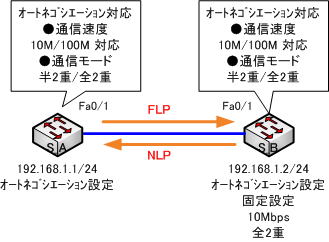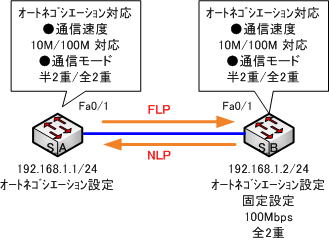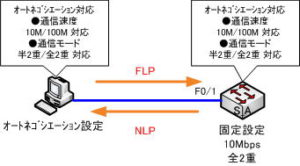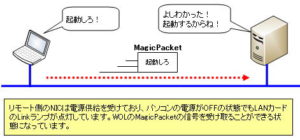Auto-negotiation failure verification
Auto-negotiation bug verification (Part 1)
Introduces the results of verification using an actual machine for the case of mode mismatch (10Mbps full duplex on the other side) in 100BASE-TX.
A Cisco switch is used here, but other companies’ switches can be used as long as the communication speed and communication mode can be specified.
The network configuration diagram is shown below.

Leave the auto-negotiation function of the S_A switch enabled, and set the f0/1 port on the S_B switch side to a communication speed of 10 Mbps and a communication mode of full duplex.
● Switch S_A setting
S_A(config)#int vlan1
S_A(config-if)#ip address 192.168.1.1 255.255.255.0
S_A(config-if)#no shutdown
● Switch S_B setting
S_B(config)#int vlan1
S_B(config-if)#ip address 192.168.1.2 255.255.255.0
S_B(config-if)#no shutdown
S_B(config-if)#int f0/1
S_B(config-if)#speed 10
S_B(config-if)#duplex full
Verification of operation
Check the console log of S_A.
● S_A console log
S_A#
01:06:08: %CDP-4-DUPLEX_MISMATCH: duplex mismatch discovered on FastEthernet0/1
(not full duplex), with S_B FastEthernet0/1 (full duplex).
The message indicates that there is a problem with the mode of operation.
From S_A, ping S_B.
S_A#ping 192.168.1.2
●S_A’s “ping” command output
S_A#ping 192.168.1.2
Type escape sequence to abort.
Sending 5, 100-byte ICMP Echos to 192.168.1.2, timeout is 2 seconds:
!!!!!
Success rate is 100 percent (5/5), round-trip min/avg/max = 1/3/12 ms
It can be confirmed that communication is possible even though a problem has occurred in the operation mode. But it’s not a favorable situation.
Check the status of the f0/1 interface on S_A.
S_A#show int f0/1
●S_A’s “ping” command output
S_A#show int f0/1
FastEthernet0/1 is up, line protocol is up (connected)
Hardware is Fast Ethernet, address is 0006.2afb.9f81 (bia 0006.2afb.9f81)
MTU 1500 bytes, BW 10000 Kbit, DLY 1000 usec,
reliability 255/255, txload 1/255, rxload 1/255
Encapsulation ARPA, loopback not set
Keepalive set (10 sec)
Half-duplex, 10Mb/s, media type is 100BaseTX
input flow-control is unsupported output flow-control is unsupported
ARP type: ARPA, ARP Timeout 04:00:00
Last input 00:00:08, output 00:00:00, output hang never
Last clearing of "show interface" counters never
Input queue: 0/75/0/0 (size/max/drops/flushes); Total output drops: 0
Queueing strategy: fifo
Output queue: 0/40 (size/max)
5 minute input rate 0 bits/sec, 0 packets/sec
5 minute output rate 0 bits/sec, 0 packets/sec
772 packets input, 124103 bytes, 31 no buffer
Received 312 broadcasts (0 multicast)
0 runts, 0 giants, 0 throttles
0 input errors, 0 CRC, 0 frame, 0 overrun, 31 ignored
0 watchdog, 231 multicast, 0 pause input
0 input packets with dribble condition detected
4872 packets output, 350610 bytes, 0 underruns
0 output errors, 0 collisions, 2 interface resets
0 babbles, 0 late collision, 1 deferred
0 lost carrier, 0 no carrier, 0 PAUSE output
0 output buffer failures, 0 output buffers swapped out
As you can see from the yellow shading above, the communication speed of S_A is 10 Mbps, which is consistent with S_A, but the operation mode is half-duplex, so it can be confirmed that they do not match.
Auto-negotiation bug verification (Part 2)
Introduces the result of verifying the case of mode mismatch (100Mbps full-duplex on the other side) with 100BASE-TX using an actual machine.
A Cisco switch is used here, but other companies’ switches can be used as long as the communication speed and communication mode can be specified.
The network configuration diagram is shown below.

Leave the auto-negotiation function of the S_A switch enabled, and set the f0/1 port on the S_B switch side to a communication speed of 10 Mbps and a communication mode of full duplex.
● Switch S_A setting
S_A(config)#int vlan1
S_A(config-if)#ip address 192.168.1.1 255.255.255.0
S_A(config-if)#no shutdown
● Switch S_B setting
S_B(config)#int vlan1
S_B(config-if)#ip address 192.168.1.2 255.255.255.0
S_B(config-if)#no shutdown
S_B(config-if)#int f0/1
S_B(config-if)#speed 100
S_B(config-if)#duplex full
◆ Verification of operation
Check the console log of S_A.
● S_A console log
S_A#
01:06:08: %CDP-4-DUPLEX_MISMATCH: duplex mismatch discovered on FastEthernet0/1
(not full duplex), with S_B FastEthernet0/1 (full duplex).
The message indicates that there is a problem with the mode of operation.
From S_A, ping S_B.
S_A#ping 192.168.1.2
●S_A’s “ping” command output
S_A#ping 192.168.1.2
Type escape sequence to abort.
Sending 5, 100-byte ICMP Echos to 192.168.1.2, timeout is 2 seconds:
!!!!!
Success rate is 100 percent (5/5), round-trip min/avg/max = 1/3/12 ms
It can be confirmed that communication is possible even though a problem has occurred in the operation mode. But it’s not a favorable situation.
Check the status of the f0/1 interface on S_A.
S_A#show int f0/1
●S_A’s “ping” command output
S_A#show int f0/1
FastEthernet0/1 is up, line protocol is up (connected)
Hardware is Fast Ethernet, address is 0006.2afb.9f81 (bia 0006.2afb.9f81)
MTU 1500 bytes, BW 10000 Kbit, DLY 1000 usec,
reliability 255/255, txload 1/255, rxload 1/255
Encapsulation ARPA, loopback not set
Keepalive set (10 sec)
Half-duplex, 10Mb/s, media type is 100BaseTX
input flow-control is unsupported output flow-control is unsupported
ARP type: ARPA, ARP Timeout 04:00:00
Last input 00:00:08, output 00:00:00, output hang never
Last clearing of "show interface" counters never
Input queue: 0/75/0/0 (size/max/drops/flushes); Total output drops: 0
Queueing strategy: fifo
Output queue: 0/40 (size/max)
5 minute input rate 0 bits/sec, 0 packets/sec
5 minute output rate 0 bits/sec, 0 packets/sec
772 packets input, 124103 bytes, 31 no buffer
Received 312 broadcasts (0 multicast)
0 runts, 0 giants, 0 throttles
0 input errors, 0 CRC, 0 frame, 0 overrun, 31 ignored
0 watchdog, 231 multicast, 0 pause input
0 input packets with dribble condition detected
4872 packets output, 350610 bytes, 0 underruns
0 output errors, 0 collisions, 2 interface resets
0 babbles, 0 late collision, 1 deferred
0 lost carrier, 0 no carrier, 0 PAUSE output
0 output buffer failures, 0 output buffers swapped out
As you can see from the yellow shading above, the communication speed of S_A is 100 Mbps, which is consistent with S_A, but the operation mode is half-duplex, so it can be confirmed that they do not match.


